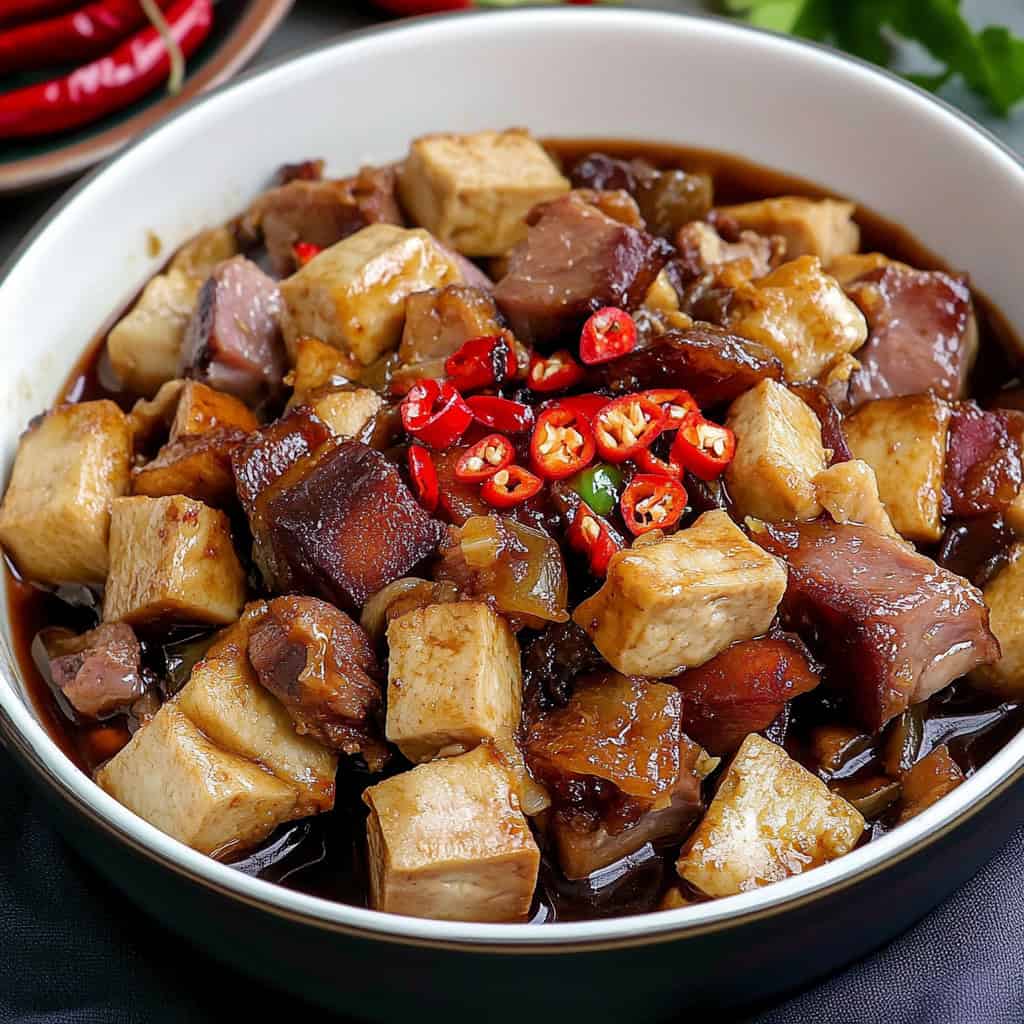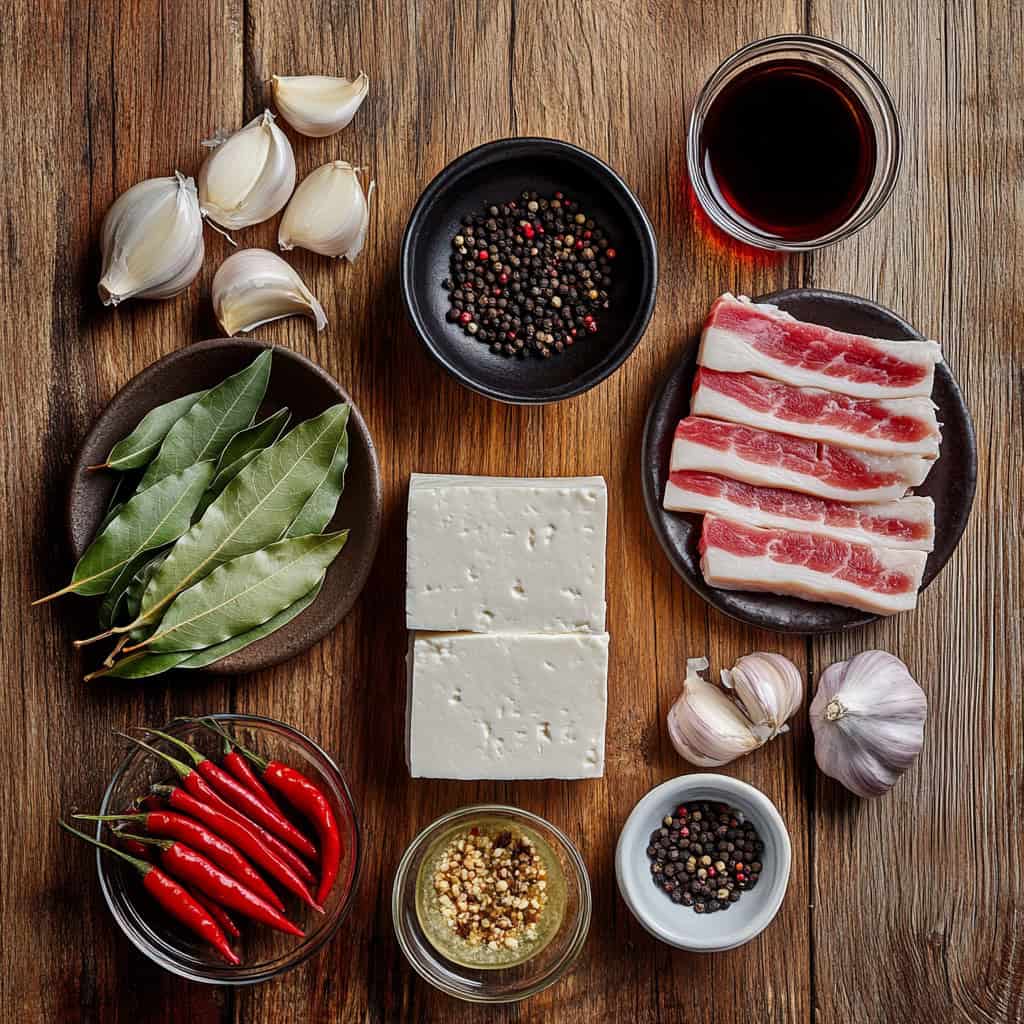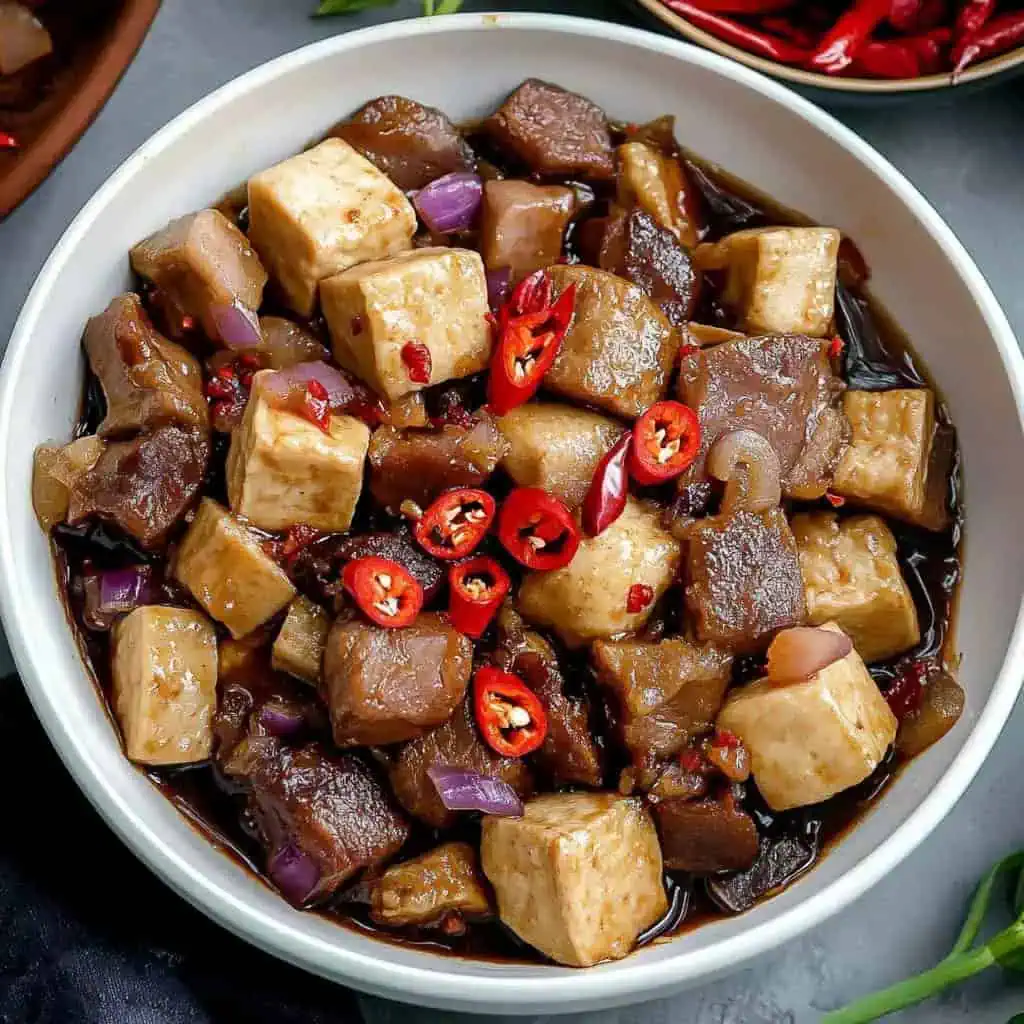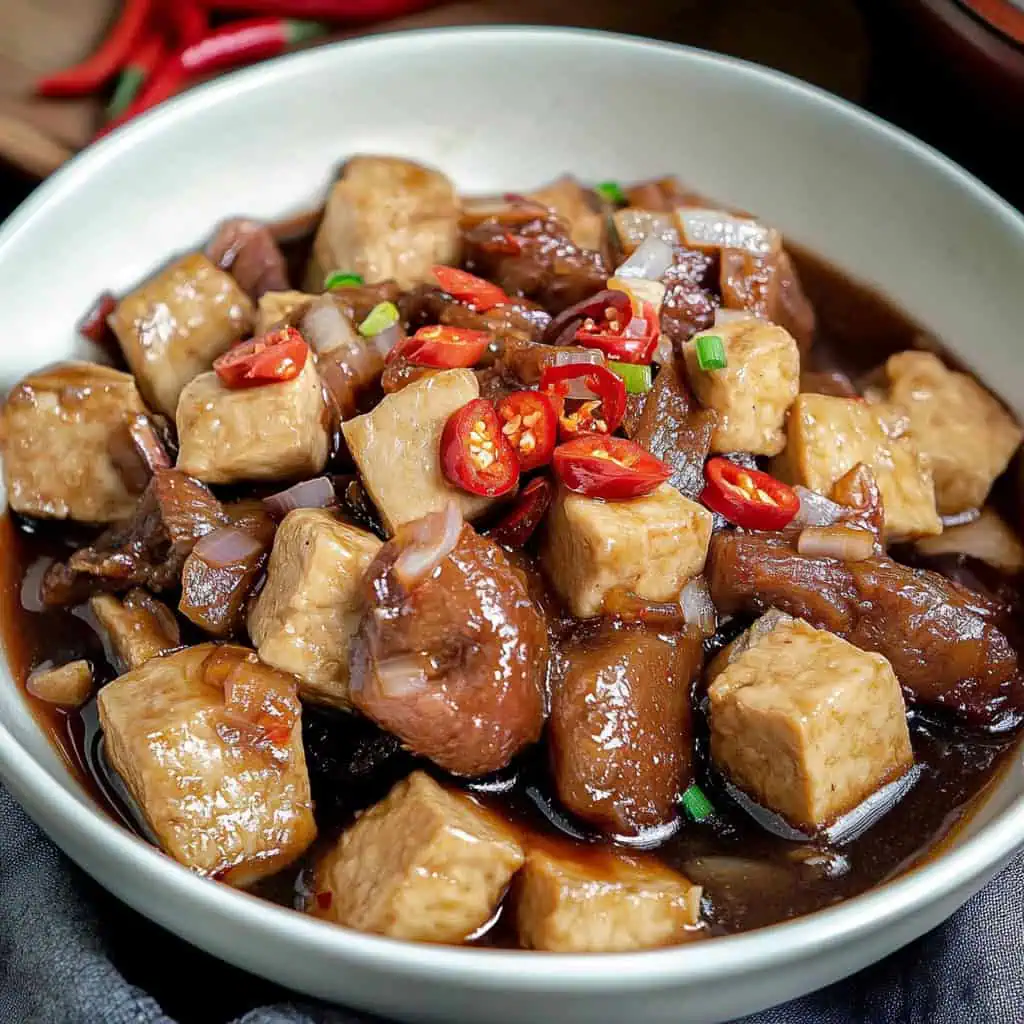Tokwa't Baboy holds a special place in my culinary journey. This beloved combination of crispy fried tofu and tender braised pork, swimming in a perfectly balanced tangy-spicy sauce, has been my go-to recipe for both casual family gatherings and special occasions.
I learned the intricate details of this dish from my mother – from achieving that golden-brown crust on the tofu to getting the sauce's acidity just right. And after years of perfecting each step, I'm excited to share our family's tested recipe with you.
Whether you're serving it as pulutan during friendly get-togethers or as a hearty topping for congee on rainy days, this recipe captures the authentic flavors that have made Tokwa't Baboy a treasured fixture in Filipino cuisine.
Follow along as I share the techniques and little secrets that will help you create this classic dish in your own kitchen.
Jump to:

Why You'll Love This Recipe
- Perfect Balance of Textures: Crispy golden tofu meets tender, succulent pork
- Versatile Dish: Works as pulutan (beer partner), lugaw topping, or main dish
- Make-Ahead Friendly: Components can be prepared in advance
- Customizable Heat Level: Adjust spiciness to your preference
- Budget-Friendly: Uses simple, accessible ingredients
- Authentic Flavor: Traditional recipe passed down through generations
Ingredients
Each element in Tokwa't Baboy serves a specific purpose: the pork ear provides unique texture while pork belly contributes richness; firm tofu creates the perfect crispy contrast; the sauce combines vinegar's tanginess, soy sauce's umami, and sugar's sweetness for balance; while fresh aromatics (garlic, onions, shallots) and chilies add complexity.
This carefully chosen combination delivers the authentic taste that has made this dish beloved across generations.

For the Pork:
- 1 piece (about ½ pound) pork ear
- 1 pound pork belly
- 1 small onion, peeled and quartered
- 1 head garlic, peeled and crushed
- 2 bay leaves
- 1 teaspoon whole black peppercorns
- 1 tablespoon salt
- Water for boiling
For the Tofu:
- 1 block (16 ounces) firm tofu
- Cooking oil for deep-frying (about 1-3 cups)
For the Sauce (Sawsawan):
- ½ cup pork broth (from cooking)
- 1 cup vinegar
- ¼ cup soy sauce
- 1 teaspoon salt
- ½ teaspoon ground black pepper
- 2 tablespoons sugar
- 4 shallots, peeled and chopped
- 2-3 Thai chili peppers, chopped
Equipment
- Large Pot: For boiling and tenderizing the pork pieces. A heavy-bottomed pot with a lid works best to ensure even cooking and to keep the meat tender.
- Deep Frying Pan or Wok: Essential for achieving perfectly crispy tofu. The high sides prevent oil splatter.
- Thermometer: Helps maintain the optimal oil temperature (350°F/175°C) for crispy tofu that's not greasy.
- Wire Rack: Placed over a baking sheet, this helps drain excess moisture from the tofu before frying.
- Paper Towels: Used to absorb excess oil after frying.
- Sharp Knife: For cutting the pork and tofu into uniform pieces, ensuring even cooking.
- Cutting Board: Preferably separate boards for meat and tofu to prevent cross-contamination.
- Slotted Spoon or Spider Strainer: For removing the tofu from hot oil without absorbing excess oil.
- Medium Saucepan: For preparing the sauce.
- Mixing Bowl: For combining all components before serving.
- Measuring Cups and Spoons: For precise ingredient measurements.

How To Make
- Begin with the pork preparation: In a large pot, combine pork ear and belly with enough water to cover. Add quartered onions, crushed garlic, bay leaves, whole peppercorns, and salt. Bring to a boil, carefully skimming off any scum that rises. Reduce heat, cover, and simmer for 45-60 minutes until fork-tender. Reserve ½ cup of the cooking liquid. Let meat cool before dicing into bite-sized pieces.
- While the pork cooks, prepare the tofu: Drain well and wrap in paper towels. Place on a wire rack with a weight on top for 20 minutes to remove excess moisture. This ensures maximum crispiness. Heat oil in a deep pan to 350°F (175°C). Cut tofu into cubes and fry until golden brown and crispy. Drain on paper towels.
- For the sauce: Combine reserved pork broth, vinegar, soy sauce, salt, pepper, and sugar in a saucepan. Bring to a boil without stirring for 3-5 minutes - this step mellows the vinegar's acidity. Add chopped shallots and chili peppers.
- For assembly: Combine the diced pork and crispy tofu in a large bowl. Pour the hot sauce over the mixture and gently toss to coat evenly. Garnish with additional shallots and chilies if desired. Serve immediately while the tofu is still crispy, either as pulutan with beer or as a topping for lugaw (congee).

Tips from Lola's Kitchen
- Choose the Right Tofu: Always use firm tofu, never silken or soft varieties. The firmer texture withstands both the pressing and frying process without falling apart.
- Proper Tofu Pressing: For ultra-crispy results, press your tofu for at least 30 minutes. Place it between paper towels with a heavy cast iron pan on top, or use a dedicated tofu press if you have one.
- The Perfect Fry: For golden brown tofu with a satisfying crunch, make sure your oil temperature is exactly 350°F. Too cool and it absorbs oil; too hot and it burns before cooking through.
- Pork Selection: Look for pork belly with a good fat-to-meat ratio. The fat renders during cooking, infusing the meat with flavor and keeping it moist.
- Vinegar Boiling Technique: Never stir the vinegar mixture immediately when it comes to a boil. Let it boil untouched for 3-5 minutes to mellow the harsh acidity - this is what separates amateur versions from restaurant-quality dishes.
- Sauce Temperature Control: Allow the sauce to cool slightly before pouring over the tofu. Extremely hot sauce will immediately soften the crispy exterior we worked so hard to achieve.
- Garlic Enhancement: For an extra layer of flavor, add 3-4 cloves of crushed garlic to the sauce during the final minute of cooking.
- Layering Method: For large gatherings, consider serving components separately - place crispy tofu on the bottom, tender pork in the middle, and serve sauce on the side so guests can add according to their preference.
Substitutions
- Pork Ears: If pork ears are unavailable, you can substitute with additional pork belly or pork shoulder for a similar rich flavor profile.
- Pork Belly: For a leaner option, substitute with pork shoulder or pork loin, though you'll lose some of the signature richness.
- Vinegar: Traditional recipes use cane vinegar (sukang iloko), but white vinegar, rice vinegar, or apple cider vinegar can work in a pinch. Each brings a slightly different flavor profile.
- Thai Chilies: Bird's eye chilies provide the authentic heat level, but red pepper flakes (adjust to taste) or even jalapeños (for milder heat) can substitute.
- Shallots: Red onions, finely chopped, can replace shallots, though they're slightly stronger in flavor.
- Soy Sauce: For a gluten-free version, use tamari or coconut aminos (though the latter is slightly sweeter).
- Tofu: While not traditional, extra-firm tofu makes the dish easier to prepare for beginners since it's less prone to falling apart.
Troubleshooting
- Soggy Tofu: If your tofu turns soggy quickly, the most common culprits are insufficient pressing before frying, oil that isn't hot enough, or pouring too-hot sauce over it. Make sure to properly press the tofu, maintain oil temperature at 350°F, and allow the sauce to cool slightly before final assembly.
- Tough Pork: If your pork remains tough after the recommended cooking time, it needs more time to break down the connective tissue. Return it to a gentle simmer and check every 15 minutes until fork-tender. Never boil aggressively as this can toughen meat further.
- Too Sour Sauce: If your sauce makes you pucker too much, balance it by adding ½ tablespoon more sugar and/or an additional 2-3 tablespoons of the reserved pork broth to mellow the acidity.
- Too Salty Dish: To fix excessive saltiness, add a splash more vinegar and a teaspoon of sugar, or dilute with a small amount of water or additional unsalted pork broth.
- Sauce Too Thin: If your sauce lacks body, simmer it uncovered for a few additional minutes to reduce and concentrate the flavors.
- Burnt Garlic Taste: If you've accidentally burnt the garlic during the pork cooking phase, don't include it in the reserved broth. Instead, add freshly sautéed garlic to the sauce near the end of cooking.
Storage & Reheating
- Refrigeration: For best results, store the components separately. Keep the cooked pork and sauce in airtight containers in the refrigerator for up to 3 days. Do not store fried tofu - it will never regain its crispiness.
- Freezing: The cooked pork pieces can be frozen for up to 2 months in a freezer-safe container. The sauce can also be frozen separately. Thaw in the refrigerator overnight before reheating. Never freeze fried tofu.
- Reheating Pork: Gently warm the pork in a saucepan with a splash of water to prevent drying out, or microwave covered with a damp paper towel.
- Reheating Sauce: Heat the sauce in a small saucepan until just simmering. Taste and adjust seasonings as needed, as flavors can change during storage.
- Fresh Tofu Preparation: For leftover servings, always fry fresh tofu. No reheating method will restore the original crispiness of fried tofu.
- Best Practice: If planning to serve leftovers, set aside unfried tofu, unheated sauce, and unsauced pork pieces separately, and complete the preparation fresh when ready to serve.

FAQ
Can I make this dish ahead of time for a party?
Yes, but prepare the components separately. Cook and store the pork and sauce up to two days ahead, then fry the tofu just before serving and assemble everything fresh. This maintains the critical texture contrast that makes this dish special.
How spicy is traditional Tokwa't Baboy?
Authentic versions have a noticeable kick but aren't overwhelmingly spicy. The recipe is completely customizable - use just one chili for mild heat, the recommended 2-3 for traditional flavor, or 4+ chilies if you prefer it spicier. You can also serve additional fresh chilies on the side.
What's the best vinegar to use for the most authentic flavor?
Cane vinegar (sukang iloko) provides the most authentic flavor profile. White vinegar is an acceptable substitute but tends to be sharper. If using white vinegar, you might want to reduce the amount slightly or add a bit more sugar to balance.
Can I use different cuts of pork?
Yes, though traditional recipes use a combination of pork ear and belly for textural contrast. The ears provide a unique chewy texture while the belly provides richness. For an easier version, using just pork belly is perfectly acceptable. Some regional variations use pork mask (face) or shoulder instead.
Why is my tofu falling apart during frying?
This typically happens when using soft or silken tofu instead of firm tofu. Also, handling the tofu too roughly or cutting the pieces too small can cause crumbling. Make sure to use firm tofu, press it well, and cut into 1-inch cubes.
Can I make a vegetarian version of this dish?
While not traditional, you can create a similar flavor profile using all tofu and a vegetable broth flavored with mushrooms for umami. The key is creating a rich, flavorful sauce with the right balance of sour, salty, and spicy elements.
How do I know when the pork is perfectly cooked?
The pork is done when you can easily pierce it with a fork with minimal resistance. The meat should be tender but still hold its shape rather than falling apart completely.
Is it necessary to boil the vinegar mixture?
Yes, this crucial step mellows the harshness of the vinegar while preserving its tangy flavor. Skipping this step will result in a sauce that's too sharp and aggressive rather than harmoniously tangy.
How long does the tofu stay crispy after adding the sauce?
The tofu begins to absorb sauce immediately, so it's best enjoyed within 15-20 minutes of assembly. For extended crispiness, serve the components separately and let each person combine them on their plate.
What makes Tokwa't Baboy different from other tofu dishes?
The distinctive combination of crispy tofu with tender pork pieces and the signature tangy-spicy sauce sets this dish apart. Unlike many Asian tofu dishes that focus on subtle flavors, Tokwa't Baboy embraces bold contrasts in both flavor and texture.
Related
Looking for other recipes like this? Try these:

Tokwa't Baboy (Filipino Tofu and Pork Dish)
Ingredients
For the Pork:
- 1 piece about ½ pound tenga ng baboy (pork ear)
- 1 pound liempo pork belly
- 1 small sibuyas onion, peeled and quartered
- 1 head bawang garlic, peeled and crushed
- 2 dahon ng laurel bay leaves
- 1 teaspoon paminta whole black peppercorns
- 1 tablespoon asin salt
- Water for boiling
For the Tofu:
- 1 block 16 ounces firm tokwa (tofu)
- 1 cup cooking oil for deep-frying enough oil for deep frying (about 1-3 cups)
For the Sauce (Sawsawan):
- ½ cup pork broth from cooking
- 1 cups suka vinegar
- ¼ cup toyo soy sauce
- 1 teaspoon asin salt
- ½ teaspoon paminta ground black pepper
- 2 tablespoons asukal sugar
- 4 sibuyas tagalog shallots, peeled and chopped
- 2-3 siling labuyo Thai chili peppers, chopped
Instructions
- Begin with the pork preparation (pagluluto ng baboy). In a large pot, combine pork ear (tenga ng baboy) and belly (liempo) with enough water to cover. Add quartered onions (sibuyas), crushed garlic (bawang), bay leaves (dahon ng laurel), whole peppercorns (paminta), and salt (asin). Bring to a boil, carefully skimming off any scum (langis) that rises. Reduce heat, cover, and simmer for 45-60 minutes until fork-tender (malutong). Reserve ½ cup of the cooking liquid (sabaw). Let meat cool before dicing into bite-sized pieces.
- While the pork cooks, prepare the tofu (tokwa). Drain well and wrap in paper towels. Place on a wire rack with a weight on top for 20 minutes to remove excess moisture (tubig). This ensures maximum crispiness. Heat oil in a deep pan to 350°F (175°C). Cut tofu into cubes and fry until golden brown and crispy (lutong-luto). Drain on paper towels.
- For the sauce (sawsawan), combine reserved pork broth, vinegar (suka), soy sauce (toyo), salt, pepper, and sugar (asukal) in a saucepan. Bring to a boil without stirring for 3-5 minutes - this step mellows the vinegar's acidity. Add chopped shallots (sibuyas tagalog) and chili peppers (siling labuyo).
- For assembly (pagbuo), combine the diced pork and crispy tofu in a large bowl. Pour the hot sauce over the mixture and gently toss to coat evenly. Garnish with additional shallots and chilies if desired. Serve immediately while the tofu is still crispy, either as pulutan with beer or as a topping for lugaw (congee).
Tips from Lola's Kitchen
- Use firm tofu, never silk or soft varieties (huwag gumamit ng malambot na tokwa)
- Press tofu well to achieve maximum crispiness
- Don't skip boiling the vinegar mixture - this step removes the harsh acidic taste
- For extra flavor, add crushed garlic to the sauce
- Let the sauce cool slightly before combining with tofu to maintain crispiness
Nutrition
The Story Behind Tokwa't Baboy
Every authentic Filipino dish has a story, and our traditional Tokwa't Baboy is no exception. This best-loved combination of crispy tofu and tender pork traces its humble beginnings to the bustling streets of Manila, where it first gained popularity as an affordable yet satisfying pulutan (beer partner) in local tiangges and carinderias during the 1960s.
Originally created by resourceful Filipino street vendors looking to make the most of affordable ingredients, this homemade recipe quickly became a masterclass in transforming simple components into something extraordinary. The genius lies in combining Chinese-influenced tofu with the Filipino's love for pork and our signature sawsawan (dipping sauce) culture, creating what would become one of the most popular easy Filipino recipes enjoyed across the archipelago.
What makes this dish truly special is how it evolved from street food to becoming a staple in Filipino family kitchens. Today, you'll find the best Tokwa't Baboy being served not just in traditional carinderia stops, but also in modern Filipino restaurants and countless family gatherings. It's that reliable dish that brings together the older generation who enjoy it with their ice-cold beer and the younger ones who love it as a topping for their hot lugaw (Filipino rice porridge).
The beauty of authentic Tokwa't Baboy lies in its versatility. While the base recipe remains traditional, every Filipino region, every family, and every household cook has their own secret twist - some add more siling labuyo for extra heat, others swear by a specific type of sukang Iloko, and many debate whether pork face or pure liempo makes for the better version. This adaptability has helped the dish maintain its relevance from generation to generation.
As more people discover the joys of Filipino cuisine, this easy-to-make dish continues to gain recognition worldwide. International food blogs and Filipino food enthusiasts praise its perfect balance of textures - the crispiness of freshly fried tofu against tender, flavorful pork, all tied together by that signature tangy-spicy sauce that makes it distinctly Pinoy.
In today's health-conscious world, many appreciate how this homemade recipe can be easily modified to suit different dietary preferences while maintaining its authentic Filipino flavors. Whether you're making it the traditional way or putting your own modern spin on it, one thing remains constant - Tokwa't Baboy embodies the Filipino talent for creating extraordinary dishes from ordinary ingredients.










Comments
No Comments